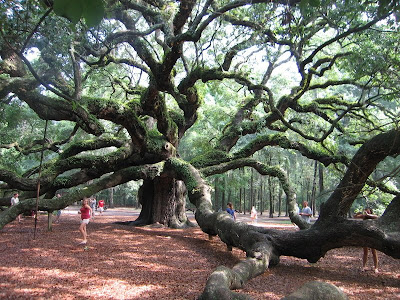Carolina was a colony founded in 1663. The two Carolinas we have now occurred in a split in 1712. Middleton Place came into being during the colonial period and was given to Henry Middleton, President of the Continental Congress, as part of a marriage dowry. A considerable plantation of its day with about 50,000 acres in rice Middleton Place today is a resort and a significant historic property and garden of about 65 acres. The historic approach to the property was by the Ashley River to which the formal layout is oriented so visitors and Master alike would get the best view of the property as they approached from Charleston.

Aerial photograph on display at garden featuring Butterfly Lakes and Central approach
The house was of Jacobean style and the formal gardens were and are rather sumptuous in their design and layout. Among the most famous features are the Butterfly Lakes which were part of the water system for flooding the rice paddies. It must be considered influenced by Versailles which was under construction and development at the same time. The continuous influence of the French during the Independence War can be seen in the gardens as well as the relationship of Middleton and Andre Michaux (who was eventually Royal Botanist to Louis XVI) who, as a consequence of their friendship, sent the first Camellias in the United States to the plantation.
Middleton family influence with the South and cessation from the Union caused the property to be targeted and the Mansion and the property to be burned in 1865. What remained was further damaged by the Great Earthquake in 1886. Since then, the family fortune has allowed, with help of all manner of enterprise, the restoration of the property. Today, Middleton Place operates as an elegant southern resort with a beautiful inn where guests have access to the garden. Most of what was plantation has been developed by neighboring communities and Charleston. Along Ashley River Road are two other well known historic properties also open to visitors: Drayton Hall and Magnolia Plantation. These offer modern varied views of how historic plantations are managed: one more historic and the other more commercial.
 Modern Archway leads into a definitely historic landscape
Modern Archway leads into a definitely historic landscape
Formal pathways framed by trees, azaleas or camellias with focal gateways are the norm

Moss covered views and brick perforated walls framing edges

Multi-purpose water features were used to manage rice paddies. Today they serve the local alligators and tourist for photo vistas
Wood Nymph was hidden and survived the assault of the Union Troops
 Modern installation near restaurant serves as an overlook on old Rice Mill and Pond
Modern installation near restaurant serves as an overlook on old Rice Mill and Pond Remaining entry stoop to the Mansion which as you can see was never rebuilt
Remaining entry stoop to the Mansion which as you can see was never rebuilt
View of formal parterre from Middleton Oak

I did not photograph the Middleton Oak as I found it sadly deformed by its loss of limbs. The tour guides at Middleton Place speak of it with great reverence and claim it to be larger than the Angel Oak featured in my last blog. I borrowed these images from the Comtesse de Sparr (above) and Joel8X (below) to give you and idea of what it is and what it was. You decide if it is grander than the Angel Oak. Personally, I think the Angel is grander and certainly older whether it is one trunk or ten!


Middleton Place is certainly a marvelous garden to visit and I hope one day to stay at the resort. My visit in June was rather late in the season and hot. Few plants were in bloom and I was rushed to see the gardens and skip the museum and slave quarters. I highly recommend that when you visit you prepare yourself for a stiff garden admission price of $25.00 (more if you visit the other historic structures) and that you do it in the vicinity of Mother's day. Then, you will enjoy the thousands upon thousands of Camellias, azaleas, and roses that abound in the garden it will also be cooler with any luck. It is a magnificent place. Regardless you will enjoy its beautiful location and hopefully you will explore a back path to the Cypress Lake where the terrain appears as though barely been touched by man or time.













